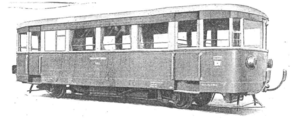CW SK 2
| CW SK 2 | |
|---|---|
|
Factory photo
|
|
| Numbering: | SK2 |
| Number: | 1 |
| Manufacturer: | Talbot wagon factory in Aachen |
| Year of construction (s): | 1935 |
| Retirement: | 1949, whereabouts unknown |
| Axis formula : | 1A |
| Gauge : | 1435 mm ( standard gauge ) |
| Length over coupling: | 10,540 mm |
| Length: | 10,070 mm |
| Height: | 3,500 mm |
| Width: | 2,900 mm |
| Total wheelbase: | 5,500 mm |
| Empty mass: | 10,300 kg |
| Top speed: | 65 km / h |
| Installed capacity: | 47 kW (65 hp) |
| Wheel diameter: | 700 mm |
| Motor type: | Daimler-Benz OM 65 |
| Motor type: | Four-cylinder four-stroke diesel engine |
| Rated speed: | 2,000 rpm |
| Power transmission: | mechanical with TAG gear |
| Brake: |
Oil pressure brake type Teves handbrake |
| Seats: | 40 |
| Floor height: | 900 mm |
| Classes : | 3. |
The two-axle diesel railcar CW SK 2 of the Kleinbahn Celle – Wittingen was procured in 1935 by the Talbot wagon factory in Aachen and was intended to replace steam operation on certain connections. It is considered a war loss, the car did not appear again in the vehicle lists after 1945.
History and commitment
After a Wismar rail bus had been running on the small train since 1933 , the company bought a second railcar two years later from the Talbot wagon factory in Aachen . This was procured in connection with the Spreewaldbahn 501 and eight railcars for the Brandenburg State Transport Authority , the later VT 135 515-516, 527-529 and 548 . The railcar had no pulling and buffing device, but only simple baffle plates and was designed for solo operation.
The railcar was in service with the Kleinbahn for about ten years. The whereabouts of the vehicle is unknown.
Constructive features
The railcar is a variant of the series for the Brandenburg State Transport Authority . In contrast to the CW SK2, these eight railcars had pulling and pushing devices. Furthermore, the CW SK2 had wheels with a diameter of only 700 mm compared to the 900 mm of the Brandenburg railcars. In contrast to the Spreewaldbahn 501 , the CW SK2 had a toilet. During the construction, emphasis was placed on standardization, which is why many components matched.
In the interior, the railcar had a passenger compartment in between, in addition to the two entry areas. The entrance doors were designed as sliding doors. The entry areas served as luggage and mail compartments.
The drive system consisted of a four-cylinder, four-stroke Daimler-Benz OM 65 diesel engine and a TAG type mechanical transmission . The engine was located under the floor approximately in the middle of the car and was fixed in a machine support frame that was mounted in the carriage of the car. The engine could be operated with brown coal tar oil without any problems .
Its output of 65 hp was sufficient for operation as a solo vehicle. The TAG gearbox was built above the drive axle, it combined manual, reversing and axle gears in one housing. This saved a cardan shaft to the drive axle. The transmission was designed so that it was easy to shift for a less experienced driver. The compressed air required for shifting was generated by an air compressor that was constantly connected to the transmission input shaft. With the drive system, the maximum speed could be reached at a distance of 1500 m between the stops, which should be 40 km / h on slopes of 1:60 with a fully occupied railcar.
The first and second gear clutches were located outside of the gearbox housing, since they were to be expected to generate the greatest amount of heat. The machine system was cooled by water cooling. This was used to heat the car body in the cold seasons.
literature
- E. Cramer: New small railcars , in: Verkehrstechnik Heft 13 from July 5, 1935
- Ingo Hütter, Thorsten Bretschneider: Die Osthannoversche Eisenbahnen , EK-Verlag, Freiburg 2010, ISBN 978-388255-730-5
